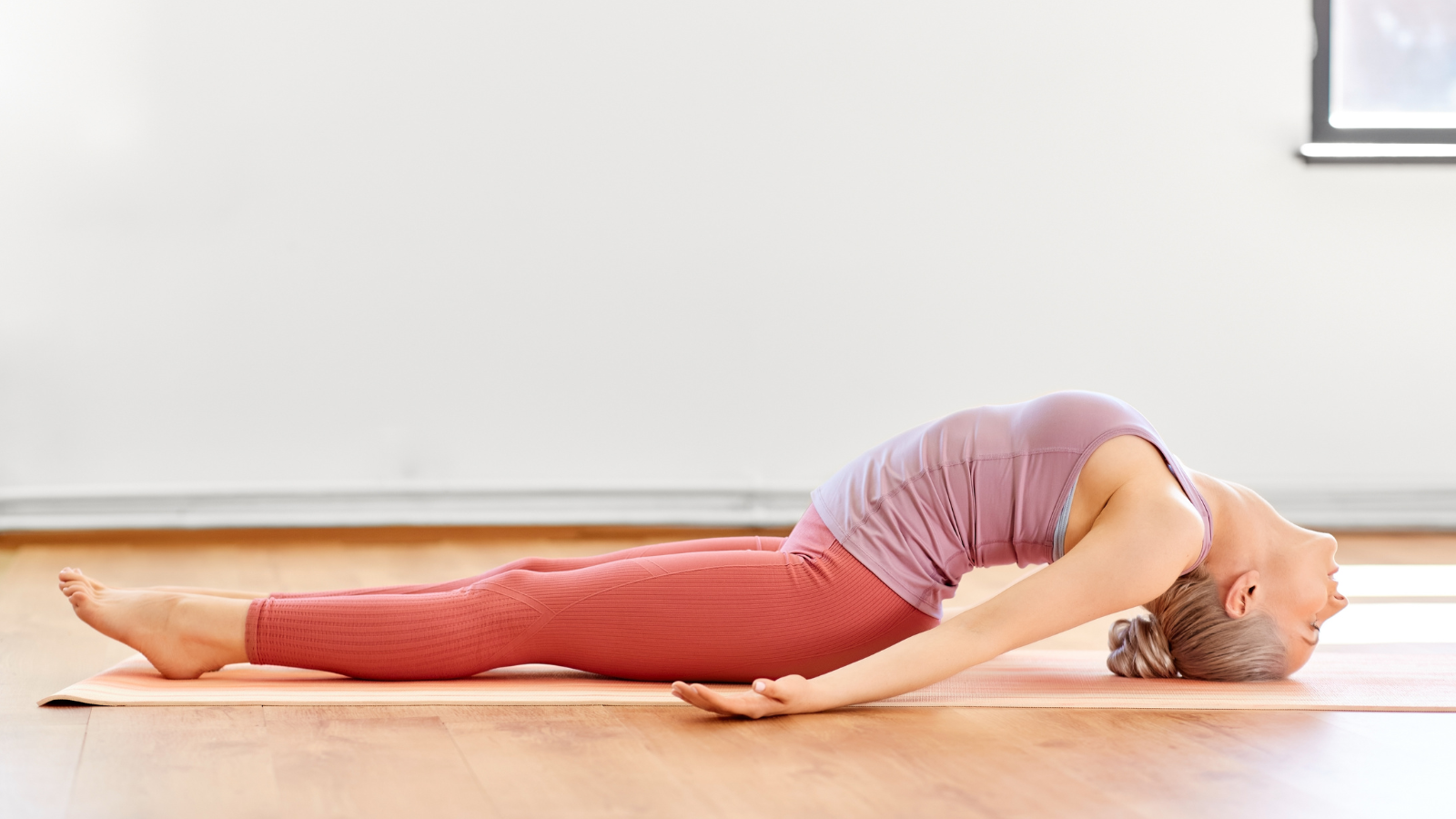Fish Pose
You've mastered the Warrior and Tree poses, now you're ready for a new challenge: the Fish Pose.
Don't worry, we've got your back!
This pose, known in Sanskrit as Matsyasana, is a fantastic way to open your chest and deep stretch out your upper body and neck.
It's tricky, but with our step-by-step guide, you'll be doing it like a pro.
So, are you ready to dive deep into your yoga practice with the Fish Pose?
Let's get started!
Key Takeaways
- Fish Pose opens the chest and stretches the neck
- It has variations that symbolize different meanings, such as liberation, unity and balance, and spiritual enlightenment
- Fish Pose empowers mental strength and physical power
- It improves posture, relieves tension in the neck and shoulders, stimulates abdominal organs, alleviates anxiety and fatigue, and enhances mental clarity and concentration.
Understanding the Fish Pose in Yoga
 During this session, you're learning about the intricacies involved in perfecting the Fish Pose in yoga. Known as Matsyasana, the Fish Pose can empower you, enhancing mental strength spinal flexibility and physical power. Now, let's explore the Fish pose variations and their symbolism.
During this session, you're learning about the intricacies involved in perfecting the Fish Pose in yoga. Known as Matsyasana, the Fish Pose can empower you, enhancing mental strength spinal flexibility and physical power. Now, let's explore the Fish pose variations and their symbolism.
The classic Fish pose, with legs extended, symbolizes a fish swimming freely, representing liberation. It's powerful, promoting chest and heart openness, reminding you to embrace vulnerability.
The bound angle variation, where your feet meet, signifies unity and balance, promoting personal growth.
The Lotus Fish pose variation, where legs are crossed in a Lotus position, symbolizes spiritual enlightenment. It's a higher level of challenge, fostering resilience and inner strength.
Step-by-Step Guide to Mastering the Fish Pose
Mastering the Fish Pose (Matsyasana) in yoga involves a series of steps that focus on alignment, breathing, and gradual progression. Here's a step-by-step guide to help you safely and effectively practice this pose:
1. Starting Position:
- Begin by sitting on a yoga mat. You can use a folded or thickly rolled blanket under your hips for extra comfort.
- Extend your legs in front of you, keeping them together. Ensure your spine is erect.
2. Preparing the Arms and Shoulders:
- Slide your hands, palms down, underneath your buttocks. This action helps in grounding through the hands and protecting your lower back.
- Press your forearms and elbows into the mat. Keep your shoulder blades firm against your back.
3. Engaging the Legs:
- Keep your legs engaged throughout the pose. If needed, you can keep your knees bent to reduce strain.
- Activate your thighs and ensure your feet are pointed or flexed, based on what feels more comfortable.
4. Lifting into the Pose:
- Inhale and press into your elbows and forearms to lift your upper torso and chest off the floor.
- Open your chest and gently tilt your head backward, allowing the top of your head to touch the floor lightly. Ensure very little weight is on your head to avoid strain on your neck.
5. Deepening the Pose:
- Maintain this position, ensuring that your chest is lifted and your shoulder blades are drawing towards each other.
- If comfortable, try to walk your elbows a little closer together, deepening the backbend.
6. Holding the Pose:
- Hold the pose for a few breaths. Focus on breathing smoothly, allowing your chest to rise and fall with each breath.
- For beginners, holding for 15-30 seconds is sufficient. Gradually increase the duration with practice.
7. Releasing the Pose:
- To release, gently lower your torso and head to the mat.
- Slide your hands out from under you and relax your arms by your side.
- If your legs were straight, bend your knees, and hug them into your chest for a gentle release.
8. Counterpose:
- After completing the Fish Pose, it's beneficial to do a gentle counterpose like Hugging Knees to Chest (Apanasana) to neutralize the spine.
Tips and Adjustments:
- If you experience discomfort in your neck or throat, adjust the tilt of your head or use a yoga block underneath your head for support.
- Always listen to your body and do not force any movement that causes pain.
- For an easier variation, perform the pose with a bolster or rolled blanket under your back.
- To deepen the pose, you can try variations like lifting your legs off the floor or crossing them in a Lotus position.
Remember, regular practice and patience are key to mastering the Fish Pose. It's more important to perform the pose correctly than to achieve the deepest possible backbend. With time and practice, you will notice increased flexibility and strength in your body.
Health Benefits of the Fish Pose
 In practicing the Fish Pose, you'll unlock numerous health benefits like improved posture, relieving tension in your neck and shoulders, and stimulating abdominal organs. As you delve deeper into Pose Variations, you'll discover newfound strength and flexibility.
In practicing the Fish Pose, you'll unlock numerous health benefits like improved posture, relieving tension in your neck and shoulders, and stimulating abdominal organs. As you delve deeper into Pose Variations, you'll discover newfound strength and flexibility.
This pose, when performed correctly, can aid in therapeutic applications by alleviating anxiety and fatigue. It's not just about elevating your chest and breathing smoothly tilting your head backward; it's a potent symbol of power, helping you tap into your inner strength. As you stretch your neck, your breathing deepens, enhancing oxygen flow to your brain.
This power pose can be a game-changer, amplifying your mental clarity and concentration. Mastering the Fish Pose isn't just about physical prowess, it's about embodying the power that comes with discipline and dedication.
Common Mistakes and Corrections in Fish Pose
Despite the physical benefits here, there's a risk of making common mistakes with the Fish Pose, such as straining your neck instead of lifting from your heart, but don't worry, we're here to guide you through the necessary corrections.
The key is achieving the right Pose Alignment. Start by laying on your back, legs straight, and hands under your hips. Lift your chest towards the ceiling, arching your back. Your spine and neck should be relaxed, not strained.
Remember, power comes from mastering the Breathing Techniques. Inhale deeply as you lift your chest, and exhale as you lower your arms. This not only enhances your strength but also the power of your pose.
With these corrections, the Fish Pose will become a powerful asset in your yoga routine.
Integrating the Fish Pose Into Your Yoga Routine
Once you've mastered the Fish Pose, it's time to integrate it into your daily yoga routine, and you'll soon notice how it enhances your flexibility and strength. To keep things fresh and continue to challenge yourself, explore Fish Pose variations. For instance, try extending one leg at a time or performing the pose with your legs in Lotus position.
Inject more power into your practice by incorporating props in Fish Pose. A yoga block under your back can intensify the stretch and build more strength. It also helps refine your alignment. Remember, it's not about how deep you go into the pose; it's about doing it correctly and safely.
Practice consistently, and you'll experience profound transformations in your physical and mental power by making the fish pose part of you routine.
Frequently Asked Questions
What Are Some Variations of the Fish Pose for Beginners or Those With Limited Flexibility?
For beginners or those with limited flexibility, using props like bolsters, blankets or yoga block underneath your back can help ease into yoga poses. Notably, these variations still offer the benefits of the original posture.
Can I Practice Fish Pose if I'm Pregnant?
Yes, you can, but your pregnancy comfort is paramount. Always consult your doctor first and remember, pose modifications are available. Yoga should empower, not strain. Listen to your body and adjust accordingly.
How Often Should I Practice Fish Pose?
Frequency depends on your yoga routine and goals. For beginners, practicing a few times a week can help build flexibility and strength. As you become more comfortable, you can include it more regularly in your practice.
What Should I Focus on During the Fish Pose to Avoid Injury?
Key focus areas are maintaining a relaxed neck, not straining the back, and ensuring smooth breathing. Keep your movements gentle and controlled, and use props if needed for support.
Can the Fish Pose Help with Back Pain?
Yes, when performed correctly, the Fish Pose can help alleviate back pain by stretching and strengthening the back muscles. However, if you have severe back issues, consult a healthcare professional before attempting any back bending yoga posture.
What Are the Mental Benefits of Practicing the Fish Pose?
Along with physical benefits, the Fish Pose can enhance mental clarity and reduce stress. The chest-opening aspect of the pose encourages deep breathing, which is calming and helps in achieving a meditative state.
Conclusion
The Fish Pose, or Matsyasana, is not just another addition to your yoga repertoire; it's a transformative practice that harmonizes the body and mind. This back bending yoga posture, with its variations, offers a spectrum of benefits, enhancing your physical and emotional well-being. Whether you're extending your legs, using a yoga block for support, or adopting a variation that suits your level, each practice of Fish Pose invites you to explore deeper layers of strength and flexibility.
As you engage your shoulder blades, upper back, and hip flexors, remember to breathe smoothly, taking a few breaths in each position. This ensures that you're not just experiencing a deep stretch in your upper body but also reaping the mental and emotional benefits, like improved self-confidence and emotional growth. With consistent practice, you'll notice a significant improvement in your spinal flexibility, a reduction in common discomforts like menstrual pain or low blood pressure, and an overall enhancement of your physical benefits.
However, it's crucial to be mindful of your body's limitations, especially if you have a neck injury or other health concerns. Adjust the pose using props like a thickly folded or rolled blanket, and modify your leg position to ensure comfort and safety. Remember, the essence of practicing yoga, including Fish Pose, lies in harmonizing the movements of your body with your breath, leading to a state of balanced well-being.
For those new to Fish Pose or those with specific health conditions like respiratory disorders or lower back issues, it's advisable to start slowly, perhaps with the support of a yoga block or blanket roll. Over time, as your body acclimatizes to the posture, you can explore more advanced variations.
In every practice, whether you're keeping your legs straight, knees bent, or exploring the counter pose, the key is to maintain focus on evenly distributing your weight and keeping your neck extended without strain. The Fish Pose offers many feelings of liberation and spiritual enlightenment, mirroring the many benefits it brings to your body and mind.
As you incorporate the Fish Pose into your routine, remember, it's not about perfecting the pose on the first try but about the journey of self-discovery and growth that comes with each practice. Whether you're looking to relieve constipation, improve internal organ function, or simply seek a moment of rest for your mind, the Fish Pose is a gateway to a healthier, more balanced you. So, take a deep breath, extend those legs or bend your knees, and dive into the transformative world of Fish Pose yoga.
